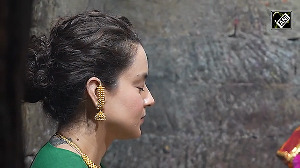On the eve of the 56th anniversary of our Independence, the First Citizen of India made an inspiring speech exhorting the other citizens to focus on building India rather than on building places of worship!
Next morning, however, played out the monotonous spectacle of an aged and jaded politician addressing the nation from the ramparts of the Red Fort, doling out the usual homilies and grand pronouncements that have no realistic chance of being implemented.
In the same week, another politician -- in his quest to become the Chief Minister of Delhi -- embarked on an incredible yatra, replete with horses, elephants and camels after dressing himself up a la one of the Ram Lila bit performer with a mace (gada) to complete the effect.
The same politician has also promised regularisation of all illegal land grab and construction activity as the sign of his and his party's commitment to the down trodden!
Modern India needs another freedom movement! A movement that can free its billion plus population from dogma. A movement that can throw up a new generation of political leadership that refrains from enacting Ram Lila's every day in our lives and instead genuinely imbibes the learning from Gita, Ramayana, Bible, Quran and other such works to usher in a genuine Ram Rajya in 21st Century India.
A movement that can inspire millions of young educated Indians to help in building an economically and socially vibrant modern India and thereby create genuine wealth for themselves and the nation.
Are we likely to get one in the foreseeable future? Fortunately for us, the coming decade could truly be the one that can usher in this second Independence for us. The answer lies in the profound demographic change that has taken place in the last 20 years and the tremendous impact it will have in the next 20.
Many of us have probably missed out the fact that India has the largest 'young' population in the world today (even compared to China). About 45 per cent of India is less than 20 years old (Yes: as many as 450 million Indians were not even born when Rajiv Gandhi became the Prime Minister of India).
By the year 2010, 70 per cent of India's population will be well below 49 years of age. Of these 750+ million young people, over 500 million will be truly literate and hence be able to take informed decisions based on sound reasoning rather than just emotion or ignorance.
This young population will be the one that will throw out the various anachronisms we have seen creeping up in our country today -- on various fronts be it political or social or commercial.
In the commercial world, we are already seeing massive shifts in the behavioural patterns. Housing is one such example. Till not so long ago, owning a house was considered amongst the last priorities for an average Indian and an investment that was usually undertaken in late 40's or early 50's in anticipation of retirement.
In just about 10 years, the average age of a typical new homebuyer has dropped to the early 30's and is going down further! Boom in the purchase of personal transport (two-wheeler as well as four), spectacular pace of increase in the penetration of mobile telephony, amazing adoption of new retail formats and shopping destinations junking traditional high streets, aspirations of young families to take frequent vacations in India and overseas, comfort with most things Indian as well as Western etc are some of the many examples of this change manifesting itself rapidly in the world of commerce.
The politician may be still acting like the 'ostrich in the sand' by refusing to acknowledge the power of this change and mistakenly treat this as an urban phenomenon confined to the so called 'educated elite' but the reality is that the change is ubiquitous across India and most marketers are already well aware of the same.
Socially, the change is very visible as well with a more comfortable mixing amongst the sexes from a very young age, more open socialising by way of meetings in the new generation coffee bars, pubs, multiplexes and shopping malls, and delay -- by choice -- in getting married and having children.
The political change will take place -- unknowingly to the geriatric leadership of today -- very rapidly in the general elections in 2004 as well as 2009 -- as hundreds of millions of young first-time voters will probably cast their franchise in favour of those who can fulfill their lofty aspirations! India may well then celebrate a second Independence!






 © 2025
© 2025